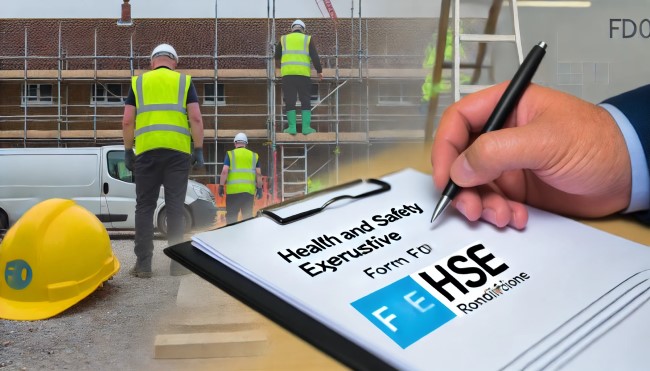Who Issues the Form F10 Certificate? A Guide to the UK Construction Industry’s Compliance Essential

The construction industry in the United Kingdom operates within a strict framework of safety and legal requirements, designed to protect both the workers and the public. One of these crucial regulatory documents is the Form F10, a notification form governed by the Health and Safety Executive (HSE) under the Construction (Design and Management) Regulations 2015 (CDM 2015). Understanding who issues the Form F10 certificate, the responsibilities involved, and when it’s needed is essential for project stakeholders to ensure legal compliance and safety throughout a project’s lifecycle.
What is Form F10?
The Purpose of Form F10
Form F10 is a document that acts as a formal notification to the Health and Safety Executive (HSE) for certain construction projects that meet specific criteria under CDM 2015. This form serves as a critical communication tool, ensuring that the HSE is aware of the project’s scope, location, and safety provisions, allowing for the enforcement of health and safety measures across the construction industry.
When is Form F10 Required?
The CDM 2015 outlines certain thresholds that make a project “notifiable” to the HSE. A project becomes notifiable if it:
- Exceeds 30 working days and has more than 20 workers simultaneously on-site.
- Exceeds 500 person-days of construction work.
These thresholds are in place to identify high-risk projects that may require additional oversight and regulation from the HSE.
Who is Responsible for Issuing the Form F10 Certificate?
The Client’s Role
According to CDM 2015, the responsibility for submitting Form F10 lies with the client, who is typically the person or organization commissioning the work. The client is accountable for ensuring that the construction project is carried out safely, which includes notifying the HSE if the project meets the notifiable criteria. Submitting this form is not a mere formality; it signifies the client’s commitment to safety compliance and regulatory adherence.
Involvement of Other Duty Holders
While the client is ultimately responsible, other duty holders in the project, such as the principal designer and principal contractor, also play a role in maintaining safety and compliance. They often assist the client by providing information required for the F10 form and ensuring ongoing adherence to safety regulations. However, the legal obligation to notify the HSE rests solely with the client.
How to Complete and Submit Form F10
Step-by-Step Submission Process
- Prepare Project Information: The client gathers details about the project, including the name, location, expected start and end dates, and contact information for key personnel like the principal designer and principal contractor.
- Access the Form: Form F10 is available on the HSE’s official website and can be completed online for convenience.
- Fill Out Required Fields: Enter all necessary information carefully, ensuring accuracy as the form will serve as an official record with the HSE.
- Submit to the HSE: Once the form is complete, submit it online. A unique serial number will be provided for tracking and reference.
Information Required on Form F10
The F10 form requires essential details about the project, including:
- Project Address: Exact location of the construction site.
- Project Timeline: Estimated start and completion dates.
- Principal Duty Holders: Names and contact details for the principal designer and principal contractor.
- Project Scope and Type: Brief description of the type of work and its scope.
These details provide the HSE with a comprehensive overview of the project, allowing it to determine if additional oversight or support may be necessary.
Legal and Safety Implications of Submitting Form F10
Ensuring Compliance with CDM 2015
Filing Form F10 is a legal requirement for notifiable projects, and failure to comply can result in serious penalties. The HSE has the authority to issue fines or even halt construction if a project is found to be non-compliant. For clients, adhering to this requirement is a matter of legal responsibility and commitment to the safety of all involved.
Importance of Safety Oversight
Submitting Form F10 enables the HSE to provide adequate safety oversight. Notifiable projects typically involve significant resources, complex tasks, or hazardous conditions, all of which require careful management and oversight. By notifying the HSE, clients and contractors can benefit from the HSE’s expertise and guidance, helping them manage potential risks effectively.
What Happens After Submitting Form F10?
HSE Review and Monitoring
Upon submission, the HSE will review the details of the project to ensure compliance with CDM 2015. While the HSE does not necessarily inspect every notified project, they have the right to visit the site, request further documentation, or halt the project if they identify significant risks or violations.
On-Site Documentation and Compliance Checks
The F10 form, once submitted, must be kept on-site and made available to the project’s workforce. It serves as proof of the project’s commitment to safety regulations and can be checked by HSE inspectors or other compliance officials. Having the F10 certificate readily accessible reinforces the safety culture on-site and ensures that all workers are aware of the regulatory framework governing their work environment.
Common Mistakes to Avoid When Issuing Form F10
Failing to Notify on Time
One of the most common errors is failing to submit Form F10 before the project begins. The CDM regulations are clear that notification should occur as soon as possible, ideally before the construction phase starts. Delays in notification can result in penalties and increase the risk of non-compliance.
Incomplete or Inaccurate Information
Another frequent issue is submitting incomplete or incorrect information on Form F10. Errors in contact details, project scope, or dates can hinder HSE’s ability to monitor and enforce safety effectively. Therefore, it’s crucial to double-check all entries before submission.
Not Updating the HSE on Project Changes
If significant changes occur during the project, such as adjustments to the timeline or duty holders, the client must update the HSE to reflect these changes. Failing to do so can lead to discrepancies and potential compliance issues, as the F10 form should accurately represent the project’s current state.
Why Compliance with Form F10 is Essential for the UK Construction Industry
Adhering to Form F10 and CDM 2015 is essential not only for legal compliance but also for fostering a culture of safety in the construction industry. Notifiable projects tend to be large and complex, with greater risks to workers and the surrounding community. Ensuring that the HSE is informed allows for a structured approach to safety, benefitting all stakeholders involved.
Conclusion
Form F10 plays a critical role in the UK construction industry by establishing a framework for safety oversight in complex projects. By knowing who issues the Form F10 certificate, understanding the submission process, and adhering to CDM 2015 regulations, clients can ensure their projects are legally compliant and prioritize worker safety. This process, while procedural, is a fundamental part of creating a safe working environment and maintaining public trust in the construction industry.

